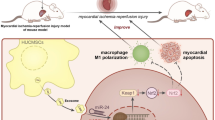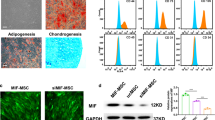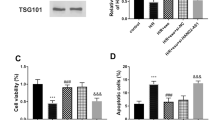Abstract
The exosome of MSCs derived from human umbilical cord blood (HUCB-MSC) has been reported to have cardioprotective effects on mouse models of acute myocardial infarction (AMI) and cardiomyocyte hypoxia injury, but the exact mechanisms involved require further investigation. This paper aimed to study the role of HUCB-MSC-exosomes in inhibiting ferroptosis to attenuate myocardial injury. Compared with sham or normoxia groups, RT-PCR and western blotting showed that divalent metal transporter 1 (DMT1) expression was significantly increased, and Prussian blue staining, ferrous iron (Fe2+), MDA, and GSH level detection demonstrated that ferroptosis occurred in the infraction myocardium and in cardiomyocyte following hypoxia-induced injury. Overexpression of DMT1 promoted H/R-induced myocardial cell ferroptosis, while knockdown of DMT1 significantly inhibited the ferroptosis. HUCB-MSCs-derived exosomes inhibited ferroptosis and reduced myocardial injury, which was abolished in exosome with miR-23a-3p knockout. Moreover, dual luciferase reporter assay confirmed that DMT1 was a target gene of miR-23a-3p. In conclusion, HUCB-MSCs-exosomes may suppress DMT1 expression by miR-23a-3p to inhibit ferroptosis and attenuate myocardial injury.







Similar content being viewed by others
References
Baba Y, Higa JK, Shimada BK, Horiuchi KM, Suhara T, Kobayashi M, et al. Protective effects of the mechanistic target of rapamycin against excess iron and ferroptosis in cardiomyocytes. Am J Physiol Heart Circ Physiol. 2018;314(3):H659–H68.
Bian S, Zhang L, Duan L, Wang X, Min Y, Yu H. Extracellular vesicles derived from human bone marrow mesenchymal stem cells promote angiogenesis in a rat myocardial infarction model. J Mol Med. 2014;92(4):387–97.
Chia-Yu W, Knutson MD. Hepatocyte divalent metal-ion transporter-1 is dispensable for hepatic iron accumulation and non-transferrin-bound iron uptake in mice. Hepatology. 2013;58(2):788–98.
Chipman LB, Pasquinelli AE. miRNA targeting: growing beyond the seed. Trends Genet. 2019;35(3):215–22.
Conrad M, Proneth B. Broken hearts: iron overload, ferroptosis and cardiomyopathy. Cell Res. 2019;29(4):263–4. https://doi.org/10.1038/s41422-019-0150-y.
Davidson SM, Ferdinandy P, Andreadou I, Bøtker HE, Heusch G, Ibáñez B, et al. Multitarget strategies to reduce myocardial ischemia/reperfusion injury: JACC Review Topic of the Week. J Am Coll Cardiol. 2019;73(1):89–99.
Dixon SJ, Lemberg KM, Lamprecht MR, Skouta R, Zaitsev EM, Gleason CE, et al. Ferroptosis: an iron-dependent form of nonapoptotic cell death. Cell. 2012;149(5):1060–72.
Du X, Xu H, Shi L, Jiang Z, Song N, Jiang H, et al. Activation of ATP-sensitive potassium channels enhances DMT1-mediated iron uptake in SK-N-SH cells in vitro. Sci Rep. 2016;6(undefined):33674.
Fang X, Wang H, Han D, Xie E, Yang X, Wei J, et al. Ferroptosis as a target for protection against cardiomyopathy. Proc Natl Acad Sci U S A. 2019;116(7):2672–80.
Ferguson SW, Wang J, Lee CJ, Liu M, Neelamegham S, Canty JM, et al. The microRNA regulatory landscape of MSC-derived exosomes: a systems view. Sci Rep. 2018;8(1):1419.
Gao M, Monian P, Quadri N, Ramasamy R, Jiang X. Glutaminolysis and transferrin regulate ferroptosis. Mol Cell. 2015;59(2):298–308.
Huang P, Wang L, Li Q, Tian X, Xu J, Xu J et al. Atorvastatin enhances the therapeutic efficacy of mesenchymal stem cells derived exosomes in acute myocardial infarction via up-regulating long non-coding RNA H19. Cardiovascular Research. 2019;undefined (undefined):undefined.
Hubert N, Hentze MW. Previously uncharacterized isoforms of divalent metal transporter (DMT)-1: implications for regulation and cellular function. Proc Natl Acad Sci U S A. 2002;99(19):12345–50. https://doi.org/10.1073/pnas.192423399.
Li LB, Chai R, Zhang S, Xu SF, Zhang YH, Li HL et al. Iron exposure and the cellular mechanisms linked to neuron degeneration in adult mice. Cells. 2019a;8(2):undefined.
Li W, Feng G, Gauthier JM, Lokshina I, Higashikubo R, Evans S, et al. Ferroptotic cell death and TLR4/Trif signaling initiate neutrophil recruitment after heart transplantation. J Clin Invest. 2019b;129(6):2293–304.
Núñez MT, Hidalgo C. Noxious iron-calcium connections in neurodegeneration. Front Neurosci. 2019;13(undefined):48.
Pujol-Giménez J, Hediger MA, Gyimesi G. A novel proton transfer mechanism in the SLC11 family of divalent metal ion transporters. Sci Rep. 2017;7(1):6194.
Simonis G, Mueller K, Schwarz P, Wiedemann S, Adler G, Strasser RH, et al. The iron-regulatory peptide hepcidin is upregulated in the ischemic and in the remote myocardium after myocardial infarction. Peptides. 2010;31(9):1786–90.
Xue X, Ramakrishnan S, Weisz K, Triner D, Xie L, Attili D, et al. Iron Uptake via DMT1 integrates cell cycle with JAK-STAT3 signaling to promote colorectal tumorigenesis. Cell Metab. 2016;24(3):447–61.
Yu H, Yang C, Jian L, Guo S, Chen R, Li K, et al. Sulfasalazine-induced ferroptosis in breast cancer cells is reduced by the inhibitory effect of estrogen receptor on the transferrin receptor. Oncol Rep. 2019;42(2):826–38.
Zhao H, Tao Z, Wang R, Liu P, Yan F, Li J, et al. MicroRNA-23a-3p attenuates oxidative stress injury in a mouse model of focal cerebral ischemia-reperfusion. Brain Res. 2014;1592(undefined):65–72.
Zhao Y, Sun X, Cao W, Ma J, Sun L, Qian H, et al. Exosomes derived from human umbilical cord mesenchymal stem cells relieve acute myocardial ischemic injury. Stem Cells Int. 2015;2015(undefined):761643.
Funding
This project was supported by The Key Science and Technology Research Projects in Henan Province (15210230149).
Author information
Authors and Affiliations
Contributions
ZG conceived and designed the analysis. YS, BW, XZ, JH, JS, JX, and ZG collected the data. YS, BW, XZ, and ZG contributed data or analysis tools. JH, JS, and JX performed the analysis. YS wrote the paper. All authors read and approved the manuscript.
Corresponding author
Ethics declarations
Conflict of interest
The authors declare that they have no conflict of interest.
Additional information
Publisher’s note
Springer Nature remains neutral with regard to jurisdictional claims in published maps and institutional affiliations.
Rights and permissions
About this article
Cite this article
Song, Y., Wang, B., Zhu, X. et al. Human umbilical cord blood–derived MSCs exosome attenuate myocardial injury by inhibiting ferroptosis in acute myocardial infarction mice. Cell Biol Toxicol 37, 51–64 (2021). https://doi.org/10.1007/s10565-020-09530-8
Received:
Accepted:
Published:
Issue Date:
DOI: https://doi.org/10.1007/s10565-020-09530-8




